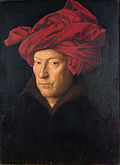
File:Eyck.hubert.lamb.750pix.jpg

| |
This is a file from the Wikimedia Commons. Information from its description page there is shown below.
Commons is a freely licensed media file repository. You can help. |
| Artist |
|
|||||||||||||||||||||||
| Title |
English: The Ghent Altarpiece (wings open)
|
|||||||||||||||||||||||
| Date | 1432 | |||||||||||||||||||||||
| Medium | oil on panel | |||||||||||||||||||||||
| Dimensions | Height: 350 cm (137.8 in). Width: 461 cm (181.5 in). | |||||||||||||||||||||||
| Current location |
|
|||||||||||||||||||||||
| Source/Photographer | Web Gallery of Art: |
|||||||||||||||||||||||
| Permission ( Reusing this file) |
|
|||||||||||||||||||||||
File usage
Metadata
| JPEG file comment | EYCK, Jan van (b. before 1395, Maaseik, d. before 1441, Bruges) The Ghent Altarpiece (wings open) 1432 Oil on wood, 350 x 461 cm Cathedral of St Bavo, Ghent The most famous work of Jan van Eyck is a huge Ghent Altarpiece with many scenes in the city of Ghent. It is said to have been begun by Jan's elder brother Hubert, of whom little is known, and was completed by Jan in 1432. On the frame a quatrain is inscribed which states that the polyptych was begun by Pictor Hubertus Eyck, and finished by his brother Jan, at the request of Jodocus Vijd, deputy burgomaster of Ghent, warden of the church of St John, and of his wife, Elisabeth Borluut, who commissioned it. The verse was placed there when the altarpiece was installed on 6 May 1432. The stylistic analysis reveals that in the painting the work of two different hands can be clearly discerned. The overall conception of the altarpiece is the work of Hubert, along with the execution of certain parts, such as the panels in the lower tier. Here, the manner is archaic, and reflects the continuing dominance of the international style that was practised by Broederlam. The composition is typically unoriginal: the landscape is still conceived as a distant background, with which the figures at the front have no organic relation, an effect that is reinforced by the bird's eye point of view. This polyptych is mystical, not to say esoteric, in intention, and is imbued throughout with both spiritual and intellectual signification. When opened, it represents the communion of saints, which is "the new heaven and the new earth", in the words of the Revelation of St John. Thus the central panel of the lower tier portrays the saints symbolizing the eight Beatitudes gathered round the altar where the sacrifice of the Lamb is taking place, at the centre of the heavenly garden which has sprung from His blood. To left and right, in the foreground, are two processions facing one another. One of these is made up of the Old Testament patriarchs and prophets, and the other of figures from the New Testament. Some of them are kneeling, barefoot. Behind them is assembled the hierarchy of the Church - popes, deacons and bishops, wearing sumptuous jewelry and clothes in the bright red of martyrdom. In the background are two further groups, facing each other as if they had just emerged from the surrounding shrubbery. These are, on one side, the Confessors of the Faith, tightly packed together and almost all dressed in blue; and on the other side, the Virgin Martyrs, holding out palm fronds and wearing in their hair crowns of flowers of a kind traditionally worn by young girls at certain holy ceremonies. In the middle of the panel, around the altar where the Lamb spills forth his blood, angels kneel, holding the emblems of His Passion. Grace is symbolized by a radiant dove hovering in the sky, and eternal life is represented by a fountain in the foreground. A paradisiacal landscape runs across all five lower panels, uniting them in a single composition. It is strewn with plants from different countries and flowers of different seasons. The central panel is vibrant with green, while those to the sides are more arid and rocky. The horizon sits high in the frame and is closed off by groves of trees, behind which clusters of fairy-tale buildings can be made out, representing the heavenly Jerusalem. The community of saints also extends onto the side panels. Magnificently arrayed horsemen, representing the Soldiers of Christ, are followed by the Just Judges. Opposite them are the Holy Hermits who have renounced the world, and the Pilgrim Saints, who were favourite figures of identification throughout the Middle Ages. They are led by a giant of a man, St Christopher. Many later commentators have suggested that his great height would have reminded the contemporary viewer of Jodocus Vijd's brother, also called Christopher. In the middle of the upper tier is God Almighty, the Word, essence and origin of the universe. He is dressed in red and is crowned with a magnificent tiara. On his left is Mary and on his right, St John the Baptist. These central figures are surrounded by angels who are singing or playing instruments. At the far right and left of the composition respectively are the figures of Adam and Eve. They were painted by Jan Van Eyck, and are set into trompe-l'oeil niches. Light and shadow play delicately over their forms which stand out as though they had been sculpted in the round.
--- Keywords: -------------- Author: EYCK, Jan van Title: The Ghent Altarpiece (wings open) Time-line: 1401-1450 School: Flemish Form: painting Type: religious |
|---|
A background to Schools Wikipedia
Wikipedia for Schools is one of SOS Children's Villages' many educational projects. SOS Children believes that a decent childhood is essential to a happy, healthy. Our community work brings families new opportunities through education, healthcare and all manner of support. If you'd like to help, learn how to sponsor a child.



